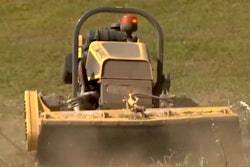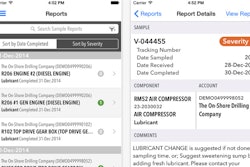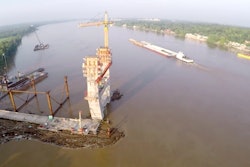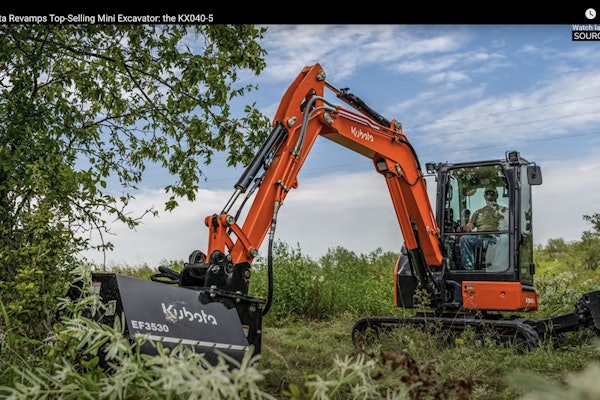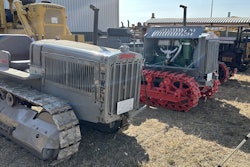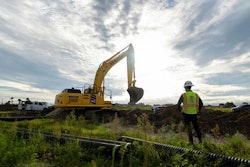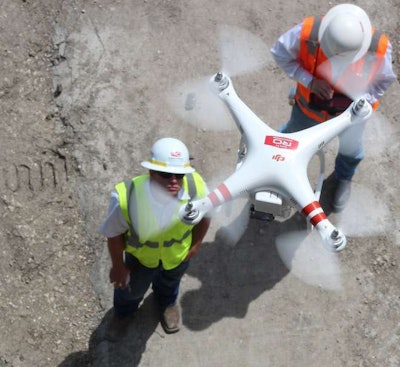
How many drones does it take to fix a leak? As Blake Potts tells it, just one.
During a recent presentation at a conference for construction IT professionals in Chicago, Potts, a virtual design and construction specialist for Texas-based general contractor Rogers-O’Brien Construction (ROB), recounted the warranty call that would alter his company’s workflow, marking the beginning of a deep integration of unmanned aerial vehicles (UAVs) that has placed Potts in charge of a veritable fleet of the machines.
After receiving the call, the company sent a couple of guys out to the building where the client reported an interior wall leak on the sixth floor. “This build had a pretty complicated facade; curtain wall, brick, a lot going on,” Potts explained. Unable to find the source of the leak through an interior inspection, ROB’s project manager for the building had a choice to make: to put workers within reach of the leak’s source and snap a couple of pictures, they could either bring in a swing stage or a boom lift.
RELATED >> How to fly a drone on the jobsite without getting sued
But neither choice was ideal. For starters, there wasn’t much room between the building and one of its neighbors to comfortably fit a boom lift, and while a swing stage would have worked, the project manager wasn’t thrilled with the cost, time and danger involved for what should be a simple task.
So he went outside the box. He went to Potts’ virtual design team, the self-described “geeks of the company,” and asked if they had any ideas or gadgets that could get the job done fast and cheap.
“We had been looking for a reason to buy a quadcopter for quite a while so…” Potts said to a chuckle from the Associated General Contractors of America’s IT Forum conference crowd. “I told the PM a UAV would cost around $1,500, we’ll buy it today, get out there and take those pictures and that’s what we did.”
“It took us about 30 minutes to fly it and took the warranty guys 30 minutes to review the video and that’s all she wrote.”
Watch three examples of ROB drone footage from active jobsites in the playlist above.
Risk and great reward
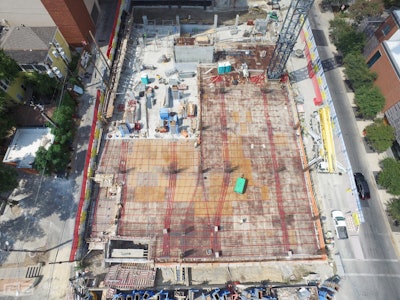 ROB’s drone photos deliver incredibly useful overhead project progress updates. Click to expand.
ROB’s drone photos deliver incredibly useful overhead project progress updates. Click to expand.That was more than two years ago. Now the company owns 10 quadcopter drones (the majority made by DJI) and employs the footage and photos gathered by the aircraft throughout its building process, from pre-construction site plans all the way through to the wrap-up photography it hands over to clients in the closeout phase.
And while the company can definitely be characterized as progressive when it comes to technology (more on that later), Potts said ROB’s full-blown adoption of drones took time. The leak inspection was just the catalyst.
“That warranty call proved to upper management and to our head of risk that this is a viable technology,” he said in an interview with Equipment World. “It’s safe. It’s something we can do easily and quickly. And once we had them on our side we were able to go company-wide.”
But even with everyone inside the company on board with the technology, the question of legality surrounding the commercial use of drones remained. Potts said the company has had its legal team involved with the implementation of the technology from day one and though the Federal Aviation Administration has yet to hand down its final rules on commercial drone use, Potts said the company has decided the immediate and numerous benefits drones provide on its jobsites outweigh any potential legal risk.
That being said, the company is in the process of applying to become one of the hundreds of construction companies to be granted a commercial drone exemption by the FAA. And flights are typically restricted to after 3:30 p.m. when most workers have left the jobsite.
“At the end of the day the risk of there being a probelm or an issue with the FAA was small compared to what we were accomplishing,” he said. “As far as UAVs go, I think everybody in the industry has got to start planning for it right now. If it’s not something on their radar, it needs to be. I really do honestly think we’re going to see an explosion; we’re going to see these aircraft everywhere.
“When people ask me ‘What should I do?’ I say do it. Just do it. I know we’re still in this kind of weird area with the FAA but just get one and figure out how to integrate it into your workflow.”
Drones spark deep change
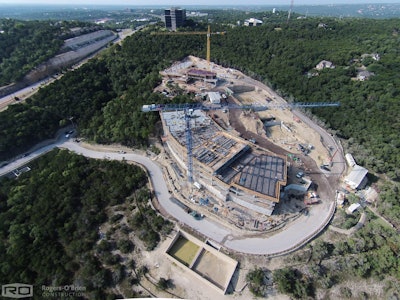
In the two years since since that first warranty inspection flight, ROB has identified at least five more applications for the aircraft that would be of great use to any firm. And it was a particular enthusiasm from ROB’s superintedents that allowed the company to discover one construction drone application we had yet to hear of.
“We have one superintedent who now wants to have a quadcopter fly his sites twice a day after having a heated discussion with a subcontractor,” Potts said. “On that project, the sub had said that the facility being built had been completely framed out and the superintendent disagreed. Within 50 minutes the superintendent had snapped a photo using a quadcopter showing all the work left to do and that ended that discussion. The next day the sub brought an extra crew to finish the work.”
ROB is also using its fleet of UAVs for the more conventional use of aerial progress photos. “On every Rogers-O’Brien job we have a budget for aerial photography once a month. Now with the quadcopter we’re able to fly sites once a week,” Potts said.
He explained that the company is still using traditional helicpoter and plane photography services on tight or highly-populated jobsites where it’s not yet feasible to pilot a UAV. However, Potts said the UAVs provide photos of comparable quality to the traditional aerial services and because they can be deployed at no cost anytime the company needs an update, they provide a much cheaper and more real-time understanding to superintendents and project managers than the traditional services ever could.
“With a helicopter you’re talking 2-3 photos, delivered two weeks later for thousands of dollars,” Potts said. “By the time you get the photos they’re outdated. Really the only thing they’re good for is framing. Plus, we can’t get a helicopter to hover 10 feet from slab ledge to make sure steel indents in a facade are in the proper place.”
In fact, the footage and photos ROB’s UAVs are capturing are so good the company has begun using them in its marketing materials, which you can watch below.
The final two drone applications the company is exploring are photogrammetry and safety.
“With photogrammetry, that’s when the UAV flies around building or site, you throw the photos it takes to a piece of software to piece together and then you end up with a model. It’s not as precise as a laser scanner but it’s also a heck of a lot quicker,” Potts explained. “We’re building contactors so we don’t do a whole lot of site work. We’re still playing with it to stitch together our buldings for a final model of the finished project.”
On the safety side, Potts said the potential of the technology there is largely wrapped up in automation.
The future of construction flight
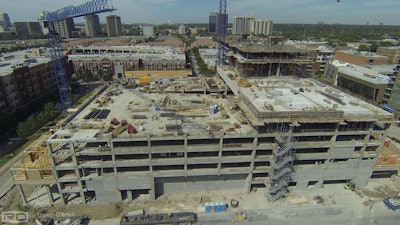
And that’s not a guess into the far future based on a drone’s potential. Potts said those are things he’s already seen a UAV prove it’s capable of doing.
“We’ve worked with a company that uses a visual programming language for progamming automated missions, so as a test, we programmed a UAV to go out and fly a jobsite and if it detected a person who wasn’t wearing our color of safety vest, to snap a picture of that and send it to us. And it worked,” he said.
“The automated stuff, once the FAA clears the way for that, that’s the future. I don’t see people flying UAVs with a remote very often in the future. Things like warranty inspections, where it’s pretty technical, maybe, if the conditions are tight. But eventually I think the piloting will be gone.”
The ease with which Potts describes these jobsites of the near future is partly due to his thousands of hours of experience using the technology in the field (for the first five months of ROB’s drone initiative, Potts bounced between five different jobsites piloting the aircraft and training colleagues on how to fly them), but it’s also due to the pro-tech culture at ROB.
The company has allocated a budget and developed a structure specifically for research and development. And an advisory board made up of people from every position at the company learns from and informs that R&D. “When I go out on the sites now I always get asked ‘Well, what’s the new gadget?’” Potts said.
He encourages other firms to do the same.
“I want to pull the industry up. I want to grab everyone and say ‘We’ve got to do this. We don’t have a choice,’” he said. “The world has changed and we have to change with it. You’ve got to be open to this stuff. Some of the stuff we’re doing, it’s not insane. We’re just pulling consumer tehnology off the shelf and putting it to use.”






